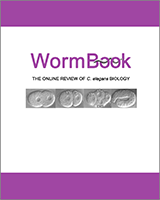Shading indicates whether the respective amine has been biochemically detected C. elegans (Pertel and Wilson, 1974; Sulston et al., 1975). Homologs for all biosynthetic enzymes exist in the C. elegans genome, but whether these homologs are utilized for the indicated biosynthetic steps is only known in the following cases: TH = tyrosine hydroxylase, encoded by cat-2; TDC = tyrosine decarboxylase, encoded by tdc-1; TBH = tyramine β-hydroxylase, encoded by tbh-1; TPH = tryptophan hydroxylase, encoded by tph-1; AAAD = aromatic amino acid decarboxylase, encoded by bas-1 for 5HT and dopamine biosynthesis; AANAT = aralkylamine N-acetyltransferase, encoded by anat-1; HIOMT = hydroxyindole-O-methyltransferase, encoded by homt-1. In other cases, indicated with “(?)”, the respective type of enzyme exists in the worm genome but its utilization is not clear: DBH (dopamine β-hydroxylase) function could be carried out by the very related TBH (tyrosine β-hydroxylase, encoded by tbh-1), but tbh-1 is not expressed in dopaminergic neurons and no norepinephrine (noradrenaline) or epinephrine (adrenaline) is readily detectable in C. elegans (Sulston et al., 1975). Aside from the characterized AAADs, bas-1 and tdc-1, there are several uncharacterized AAADs in the genome (hdl-1, hdl-2, basl-1, see text) that could serve to generate the trace amines tryptamine, histidine or phenylethylamine. In regard to PNMT (Phenylethanolamine N-methyltransferase), which generates epinephrine and synephrine in other species, there are three paralogous genes in the C. elegans genome (anmt-1 through anmt-3) which are equidistant to PNMT and its related enzymes indolethylamine N-methyltransferase (INMT) and nicotinamide N-methyltransferase (NNMT). INMT and NNMT are not involved in neurotransmitter metabolism but are generally thought to target xenobiotic compounds. The tyrosine-derived neuromodulators dopamine, norepinephrine and epinephrine are also referred to as “catecholamines” (benzene with two hydroxyl groups and a side-chain amine). Tryptophan-derived neuromodulators are also sometimes referred to as “indolamines” (benzene with nitrogen-containing pyrrol ring). In vertebrates, tyramine, octopamine, synephrine, tryptamine, histamine and phenylethylamine are generally considered trace amines.


